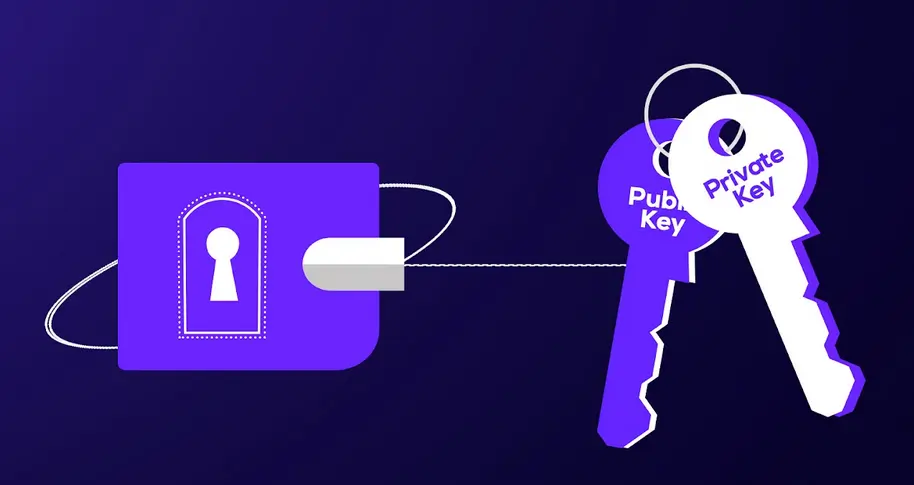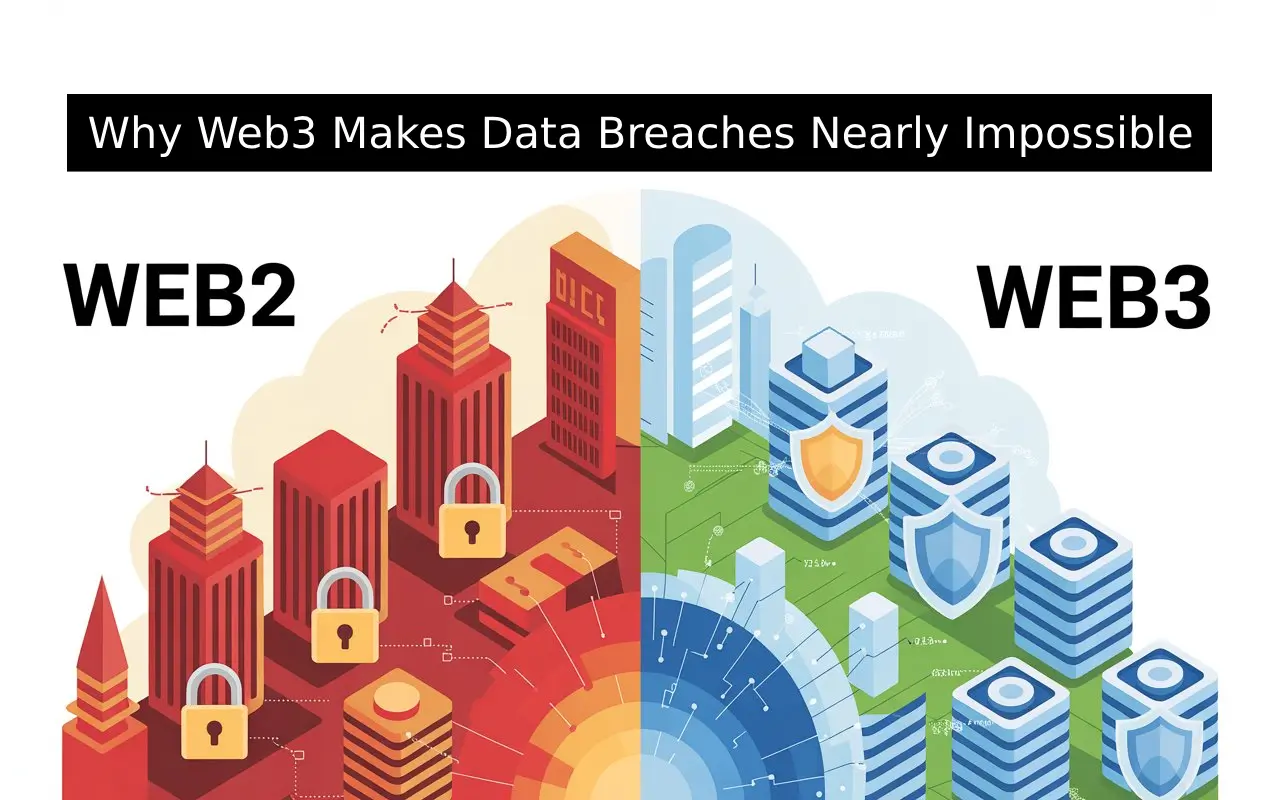Your company handles sensitive customer data daily. Every transaction, every user interaction, every piece of information flowing through your systems carries risk.
The question isn’t whether you’ll face a data breach. It’s when, and how prepared you’ll be.
Traditional Web2 architecture leaves your data exposed. Centralized servers create single points of failure. One successful attack can compromise everything.
Web3 promises a different approach, but does it deliver on security?
The Web2 Data Safety Reality Check

Web2 built the internet we know today. Social media, e-commerce, cloud computing – all powered by centralized systems where data lives on company-owned servers.
How Web2 Handles Your Data:
- Companies store user information on centralized databases
- Third-party services control access and security protocols
- Users surrender data ownership for platform access
- Single servers become attractive targets for hackers
The numbers tell the story. In 2023, data breaches exposed over 3.2 billion records globally. Facebook, Equifax, Yahoo – household names became synonymous with massive security failures.
Why Web2 Creates Vulnerabilities:
Your data sits in one place, protected by one company’s security measures. When that protection fails, everything falls apart simultaneously.
Hackers need to crack just one system to access millions of user records.
Companies monetize your information without your direct consent. Your browsing habits, purchase history, and personal preferences become products sold to advertisers and third parties.
Web3’s Security Revolution
Web3 takes a radically different approach. Instead of storing data in centralized locations, it distributes information across blockchain networks.
Key Security Advantages:
- Decentralized Storage: Data spreads across multiple nodes, eliminating single points of failure
- Cryptographic Protection: Advanced encryption secures every transaction and data transfer
- User Ownership: Individuals control their own data through private keys
- Transparent Operations: All transactions record publicly on immutable ledgers
Smart Contracts Replace Trust:
Traditional agreements require intermediaries – banks, lawyers, or platform operators. Smart contracts execute automatically when conditions are met, removing human error and reducing fraud opportunities.
Data Control: Who Really Owns Your Information?
Web2 Model: You create an account, agree to terms of service, and surrender data control to the platform. Companies can modify privacy policies, share information with partners, or restrict your access at any time.
Web3 Alternative: You hold private keys that prove ownership of your data and digital assets. No central authority can freeze your account, censor your content, or sell your information without permission.
Privacy Protection Comparison

Web2 Privacy Limitations:
- Personal information stored alongside identifying details
- Companies track behavior across multiple platforms
- Data sharing agreements often buried in lengthy terms of service
- Limited user control over information deletion or modification
Web3 Privacy Features:
- Pseudonymous transactions protect real-world identity
- Users choose what information to share and with whom
- Zero-knowledge proofs verify credentials without revealing underlying data
- Immutable records prevent unauthorized data modification
Data Security Breach Impact Analysis
When Web2 systems fail, the damage spreads quickly:
- Immediate Exposure: Hackers access entire databases at once
- Identity Theft Risk: Personal details enable account takeovers
- Financial Loss: Credit card numbers and bank details get compromised
- Reputation Damage: Companies face lawsuits and customer exodus
Web3 breaches look different:
- Limited Scope: Individual accounts face risk, not entire user bases
- Self-Custody: Users control their own security measures
- Transparent Tracking: Blockchain records show exactly what happened
- Recovery Options: Smart contracts can include recovery mechanisms
Current Web3 Challenges
Web3 isn’t perfect. New technology brings new risks:
User Education Gap: Managing private keys requires technical knowledge many users lack. Lose your private key, lose access to your data and assets permanently.
Scalability Issues: Blockchain networks process fewer transactions per second than traditional databases. This limitation affects user experience and adoption rates.
Regulatory Uncertainty: Governments worldwide are still developing frameworks for blockchain technology. Compliance requirements remain unclear in many jurisdictions.
Smart Contract Vulnerabilities: Code errors in smart contracts can create security holes. Once deployed, these contracts often can’t be modified, making bugs permanent.
Practical Implementation for Businesses

Evaluating Web3 for Your Company:
Start small with pilot projects. Test blockchain solutions for specific use cases like supply chain tracking or customer loyalty programs.
Consider hybrid approaches that combine Web2 reliability with Web3 security features. Many successful implementations use traditional databases for routine operations while leveraging blockchain for sensitive transactions.
Security Best Practices:
- Implement multi-signature wallets for high-value transactions
- Regular security audits of smart contracts
- Employee training on blockchain security principles
- Backup and recovery procedures for private keys
Cost-Benefit Analysis
Web2 Security Costs:
- Server maintenance and security updates
- Cybersecurity insurance premiums
- Compliance and audit expenses
- Potential breach remediation costs
Web3 Implementation Costs:
- Initial development and migration expenses
- Staff training and technical expertise
- Network transaction fees
- Smart contract audit and testing
Factor in the potential costs of NOT upgrading your security infrastructure. A single major breach can cost millions in direct expenses, regulatory fines, and lost customer trust.
Making the Transition Decision
Your industry and risk profile determine the urgency of Web3 adoption:
High Priority Industries:
- Financial services handling sensitive payment data
- Healthcare organizations managing patient records
- Supply chain companies tracking valuable goods
- Identity verification and authentication services
Gradual Adoption Approach: Start with non-critical systems to gain experience. Build internal expertise before migrating essential business functions.
Are You Using Web3 Data Security Yet?
Web2 and Web3 each serve different security needs. Web2 offers familiar, proven systems with centralized control and support. Web3 provides enhanced security through decentralization but requires new technical skills and approaches.
The choice isn’t binary. Most organizations will operate hybrid systems for the foreseeable future, using Web3 for high-security applications while maintaining Web2 infrastructure for routine operations.
Your data safety strategy should match your business requirements, technical capabilities, and risk tolerance. The question isn’t whether Web3 is “better” than Web2—it’s which approach best protects your specific data and serves your customers’ needs.
Action Steps:
- Audit your current data storage and security practices
- Identify high-risk data that would benefit from decentralized protection
- Research Web3 solutions relevant to your industry
- Start with small pilot projects to build expertise
- Develop a long-term migration strategy based on results
The future of data safety likely includes both Web2 and Web3 technologies working together. Understanding the strengths and limitations of each approach helps you make informed decisions that protect your business and customers.
_________________________________________________________________
Want to know how to increase customers and sales for your business?
Tap here to chat to me and I’ll show you how we make it happen.
If you’ve enjoyed reading today’s blog, please share our blog link below.
Do you have a blog on business and marketing that you’d like to share on influxjuice.com/blog? Contact me at rob@influxjuice.com.
Want to know how we can guarantee a mighty boost to your traffic, rank, reputation and authority in you niche?
Click here to access our free 3-Step Marketing Playbook – ‘SEM/GEM Guide’.

